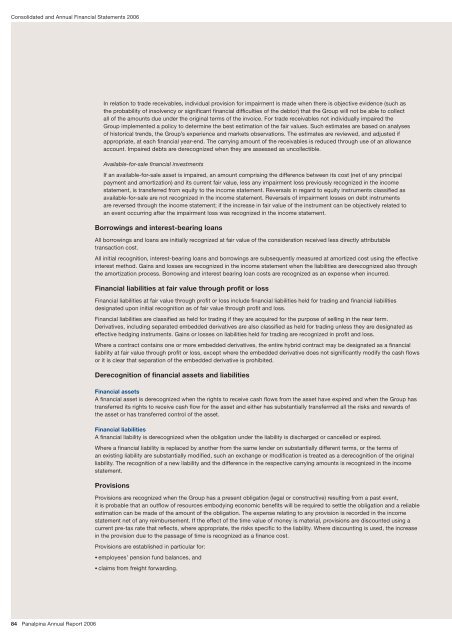Panalpina Annual Report 2006
Panalpina Annual Report 2006
Panalpina Annual Report 2006
Create successful ePaper yourself
Turn your PDF publications into a flip-book with our unique Google optimized e-Paper software.
Consolidated and <strong>Annual</strong> Financial Statements <strong>2006</strong><br />
84 <strong>Panalpina</strong> <strong>Annual</strong> <strong>Report</strong> <strong>2006</strong><br />
In relation to trade receivables, individual provision for impairment is made when there is objective evidence (such as<br />
the probability of insolvency or significant financial difficulties of the debtor) that the Group will not be able to collect<br />
all of the amounts due under the original terms of the invoice. For trade receivables not individually impaired the<br />
Group implemented a policy to determine the best estimation of the fair values. Such estimates are based on analyses<br />
of historical trends, the Group’s experience and markets observations. The estimates are reviewed, and adjusted if<br />
appropriate, at each financial year-end. The carrying amount of the receivables is reduced through use of an allowance<br />
account. Impaired debts are derecognized when they are assessed as uncollectible.<br />
Available-for-sale financial investments<br />
If an available-for-sale asset is impaired, an amount comprising the difference between its cost (net of any principal<br />
payment and amortization) and its current fair value, less any impairment loss previously recognized in the income<br />
statement, is transferred from equity to the income statement. Reversals in regard to equity instruments classified as<br />
available-for-sale are not recognized in the income statement. Reversals of impairment losses on debt instruments<br />
are reversed through the income statement; if the increase in fair value of the instrument can be objectively related to<br />
an event occurring after the impairment loss was recognized in the income statement.<br />
Borrowings and interest-bearing loans<br />
All borrowings and loans are initially recognized at fair value of the consideration received less directly attributable<br />
transaction cost.<br />
All initial recognition, interest-bearing loans and borrowings are subsequently measured at amortized cost using the effective<br />
interest method. Gains and losses are recognized in the income statement when the liabilities are derecognized also through<br />
the amortization process. Borrowing and interest bearing loan costs are recognized as an expense when incurred.<br />
Financial liabilities at fair value through profit or loss<br />
Financial liabilities at fair value through profit or loss include financial liabilities held for trading and financial liabilities<br />
designated upon initial recognition as of fair value through profit and loss.<br />
Financial liabilities are classified as held for trading if they are acquired for the purpose of selling in the near term.<br />
Derivatives, including separated embedded derivatives are also classified as held for trading unless they are designated as<br />
effective hedging instruments. Gains or losses on liabilities held for trading are recognized in profit and loss.<br />
Where a contract contains one or more embedded derivatives, the entire hybrid contract may be designated as a financial<br />
liability at fair value through profit or loss, except where the embedded derivative does not significantly modify the cash flows<br />
or it is clear that separation of the embedded derivative is prohibited.<br />
Derecognition of financial assets and liabilities<br />
Financial assets<br />
A financial asset is derecognized when the rights to receive cash flows from the asset have expired and when the Group has<br />
transferred its rights to receive cash flow for the asset and either has substantially transferrred all the risks and rewards of<br />
the asset or has transferred control of the asset.<br />
Financial liabilities<br />
A financial liability is derecognized when the obligation under the liability is discharged or cancelled or expired.<br />
Where a financial liability is replaced by another from the same lender on substantially different terms, or the terms of<br />
an existing liability are substantially modified, such an exchange or modification is treated as a derecognition of the original<br />
liability. The recognition of a new liability and the difference in the respective carrying amounts is recognized in the income<br />
statement.<br />
Provisions<br />
Provisions are recognized when the Group has a present obligation (legal or constructive) resulting from a past event,<br />
it is probable that an outflow of resources embodying economic benefits will be required to settle the obligation and a reliable<br />
estimation can be made of the amount of the obligation. The expense relating to any provision is recorded in the income<br />
statement net of any reimbursement. If the effect of the time value of money is material, provisions are discounted using a<br />
current pre-tax rate that reflects, where appropriate, the risks specific to the liability. Where discounting is used, the increase<br />
in the provision due to the passage of time is recognized as a finance cost.<br />
Provisions are established in particular for:<br />
• employees’ pension fund balances, and<br />
• claims from freight forwarding.



![Eigenes Luftfrachtnetzwerk [pdf | 244 KB] - Panalpina](https://img.yumpu.com/23347328/1/184x260/eigenes-luftfrachtnetzwerk-pdf-244-kb-panalpina.jpg?quality=85)
![Übersicht Panalpina [pdf | 240 KB]](https://img.yumpu.com/22547731/1/184x260/ubersicht-panalpina-pdf-240-kb.jpg?quality=85)

![Seefracht [pdf | 181 KB] - Panalpina](https://img.yumpu.com/22234724/1/184x260/seefracht-pdf-181-kb-panalpina.jpg?quality=85)



![Annual Report 2012 [pdf | 1 MB] - Panalpina](https://img.yumpu.com/15342099/1/184x260/annual-report-2012-pdf-1-mb-panalpina.jpg?quality=85)






